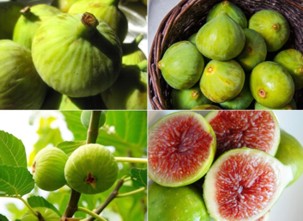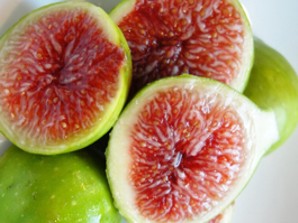| Perennial / Desiduous Trees / Sweet Honey FIG Fragrant ( King Figs ) |
|
|
|
|
| |
|
Plant name - Fig
|

|
|
 |
|
 |
| Common name - Ficus carica
|
| Plant type - Desiduous |
| Vegetation type -
Perennial |
| Growth rate - Fast |
| Leaf / Flower color
- Green / Green |
| Other names - King Fig
|
| |
| Description : |
|
|
|
|
|
It is a gynodioecious (functionally dioecious), deciduous tree or large shrub, growing to a height of 7–10 metres (23–33 ft), with smooth white bark. Its fragrant leaves are 12–25 centimetres (4.7–9.8 in) long and 10–18 centimetres (3.9–7.1 in) across, and deeply lobed with three or five lobes.
The complex inflorescence consists of a hollow fleshy structure called the syconium, which is lined with numerous unisexual flowers. The flower itself is not visible outwardly, as it blooms inside the infructescence.
Although commonly referred to as a fruit, the fig is actually the infructescence or scion of the tree, known as a false fruit or multiple fruit, in which the flowers and seeds are borne. It is a hollow-ended stem containing many flowers.
The small orifice (ostiole) visible on the middle of the fruit is a narrow passage, which allows the specialized fig wasp Blastophaga psenes to enter the fruit and pollinate the flower, whereafter the fruit grows seeds.
.
|
| |
| Growing Instructions : |
* Place soil in a pot so it is filled 3/4 of the way to the brim.
* Place seeds a few inches apart in the soil.
* Cover seeds with soil (to the top of the pot), so they are embedded.
* Place seeds in direct light (sunlight is best) for eight hours per day. Water as often as you need to keep the soil damp; never let the soil dry out.
"* Allow 20 to 35 days to pass.
* Observe the seeds, take the most promising growth (the biggest/greenest leaves) and place seedling in its own pot.
* Allow to grow in sunlight, with plenty of water, for 10 or 15 more days."
* Do not attempt to plant outside without a root structure in place from the the seed growth.
* Plant only after you are sure there will be no more frost, new figs will not survive the winter.
* Plant the tree where it will get a lot of sunlight; avoid shade.
|
| |
|
|
| Sweet Honey FIG ( White Figs 2 crops) Fragrant |
|
|
|
| |
|
Plant name - White fig 2 crops
|

|
|
 |
|
 |
| Common name - Ficus carica
|
| Plant type - Desiduous |
| Vegetation type -
Perennial |
| Growth rate - Fast |
| Leaf / Flower color
- Green / Green |
| Other names - White Fig
|
| |
| Description : |
|
|
|
|
|
It is a gynodioecious (functionally dioecious), deciduous tree or large shrub, growing to a height of 7–10 metres (23–33 ft), with smooth white bark. Its fragrant leaves are 12–25 centimetres (4.7–9.8 in) long and 10–18 centimetres (3.9–7.1 in) across, and deeply lobed with three or five lobes.
The complex inflorescence consists of a hollow fleshy structure called the syconium, which is lined with numerous unisexual flowers. The flower itself is not visible outwardly, as it blooms inside the infructescence.
Although commonly referred to as a fruit, the fig is actually the infructescence or scion of the tree, known as a false fruit or multiple fruit, in which the flowers and seeds are borne. It is a hollow-ended stem containing many flowers.
The small orifice (ostiole) visible on the middle of the fruit is a narrow passage, which allows the specialized fig wasp Blastophaga psenes to enter the fruit and pollinate the flower, whereafter the fruit grows seeds.
.
|
| |
| Growing Instructions : |
* Place soil in a pot so it is filled 3/4 of the way to the brim.
* Place seeds a few inches apart in the soil.
* Cover seeds with soil (to the top of the pot), so they are embedded.
* Place seeds in direct light (sunlight is best) for eight hours per day. Water as often as you need to keep the soil damp; never let the soil dry out.
"* Allow 20 to 35 days to pass.
* Observe the seeds, take the most promising growth (the biggest/greenest leaves) and place seedling in its own pot.
* Allow to grow in sunlight, with plenty of water, for 10 or 15 more days."
* Do not attempt to plant outside without a root structure in place from the the seed growth.
* Plant only after you are sure there will be no more frost, new figs will not survive the winter.
* Plant the tree where it will get a lot of sunlight; avoid shade.
|
| |
|
|
|
|
|
|
